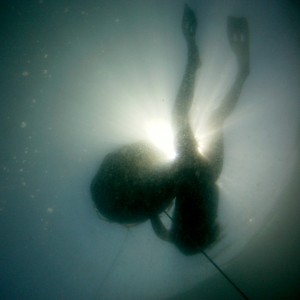Freedive & Yoga – same same but different?
It is no coincidence that many freedivers are also adept yogis. It is pretty much common knowledge that yoga offers great benefits for freedivers, such as the pranayama exercises for breath control or udjana bandha for the flexibility of the diaphragm, just to mention two well discussed topics. But I would like to take it one step further and say that yoga and freediving are basically the same art form of body movement.
To move in water, I have to become water – but what does this exactly mean? It means that I have to learn and train to use only those muscles that are needed to move my body in a given way – and relax all other muscles completely. I have to learn to let go of any unneeded firmness and that includes tiny muscles like the tip of my little finger or my eyelid as much as big oxygen users like upper back muscles or shoulders. Now, here we got the connection to yoga: As a yoga beginner I find it very hard to keep a posture for more than a few brief moments. I guess that’s why there is this misconception of “I’m not fit enough to do yoga”. Of course, as yogis we will develop strength and flexibility, but most importantly we are unconsciously creating this unbearably high workload ourselves! How? By keeping many muscles contracted all trough holding a posture, including many muscles which are actually not needed to hold that certain position.
Here’s a little exercise for you to play around: Go into a forearm plank position, with a very straight body, only your forearms and toes touching the ground. Don’t allow your torso to neither bend up- nor downwards – keep your body straight as plank! Can you let go of firmness in your belly? Try! It is unneeded for holding the plank!
In my yoga practice I try to live up to the basic principle of letting go any unneeded firmness by constantly checking on myself:
- Keep abdomen, fingers and face relaxed. Always. Wiggle the fingertips, make a little belly-roll by slightly contracting the abdomen and diaphragm alternatively and – of course – put a smile on my face.
- Allow the breath to follow the move. I work on NOT to inhale purposely – it happens by itself in the right amount, if I let it to happen. This way, my breathing alway stays small and relaxed. And so does the heartbeat.
- While holding a posture, I do a relaxation check: Scan the body with the mental torch (remember, dear students?) for unneeded tension and firmness – and let go of it.
Exercising yoga this way teaches my body to become a minimalist, capable to move into and hold postures with a minimum input of energy. And this is exactly what freediving is about as well. In the end, freediving and yoga are not only about static position holding, but of greatest imporntance is always the interplay of contracting and relaxing muscles – activate and let go of them in a fluent movement! It takes repetition and self control to achieve this, and, most of all, a great deal of honesty with yourself in your daily practice.
Enjoy yoga while your stay in Bali!
May the dive response be with you!
Oli

